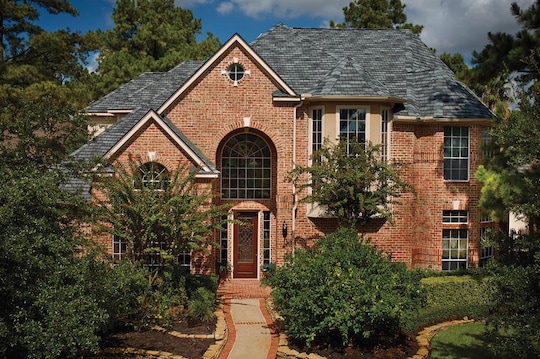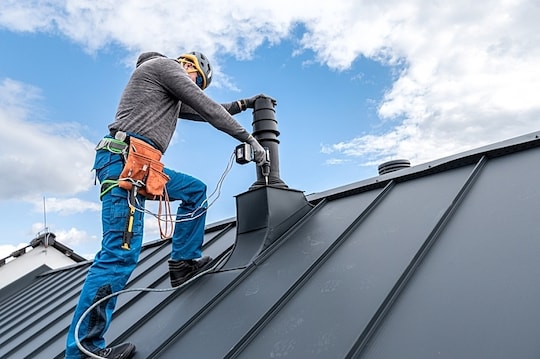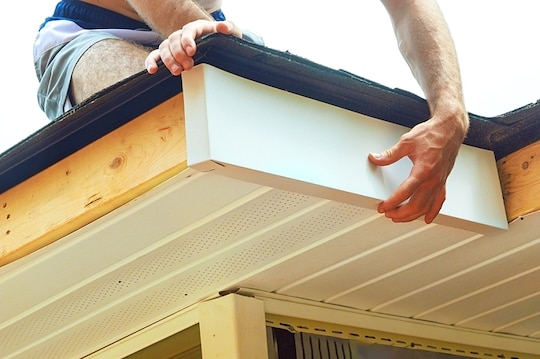
Un système de ventilation de grenier équilibré est important pour éviter des problèmes avec le système de toiture. Ce système de ventilation consiste en l'installation d'évents de faîtière sur le faîte et d'évents d'entrée dans la sous-face ou près de cette dernière. Une ventilation adéquate de votre grenier réduit l'excès de chaleur et d'humidité en été et permet de conserver le système de toiture froid pendant l'hiver afin de réduire le cycle du gel et du dégel qui crée des digues de glace.
What is a ridge vent?
A ridge vent is an air exhaust vent installed on the peak of a roof. When installing this vent, an air slot is first cut in the roof deck at the roof's peak. This air slot is then covered by the ridge vent itself. They help to provide continuous, uniform exhaust ventilation at the highest portion of the attic and are designed to help resist wind-driven rain and snow, as well as insect and debris infiltration. Ridge cap shingles are then typically installed over the ridge vent to protect it, and provide a clean finished look on the roof, with the exception of metal ridge vents which do not require the use of ridge cap shingles.
For the attic ventilation system to work properly, air needs to be able to enter the attic as well as exit it to provide a continuous flow of outside air through the attic space. Eave and soffit vents, or vents placed where a roof or overhang juts out over the home's exterior wall, will allow cooler, dry air to enter the lower attic space. As the air in the attic heats up, convection helps push the air to the peak of the roof where it escapes through the ridge vent. This type of "passive system" is an efficient way to ventilate an attic, as it doesn't require any energy to properly function.
When are they needed?
Depending on the amount of exhaust ventilation needed for the attic space and the physical roof design, many homes are great candidates for ridge vents. For example, homes that have an ample amount of ridge line are often properly ventilated using ridge vents.
If your attic is finished or the air in the space is conditioned, you may need a mechanical method of exhausting heat and moisture. You should consult a design professional or HVAC contractor to make sure your system is large enough to create the airflow needed to keep your attic cool.
The 1:300 rule
How much venting do you need for your attic? The Federal Housing Administration recommends that for every 300 square feet of ceiling space, you will need a minimum of one square foot of attic ventilation (evenly split between intake and exhaust ventilation). Note that the attic ventilation should always be clear of obstructions that can interfere with airflow. Local code requirements may differ, so be sure to discuss with your contractor or consult local building code in your area.
The amount of exhaust ventilation provided by the ridge vent should never exceed the amount of intake ventilation from the soffit or eave vent. If it does, you may not get enough airflow to properly ventilate the attic. It's critical to always have balanced attic ventilation.
You can calculate your attic's ventilation needs with the GAF Ventilation Calculator.
Ridge venting solutions
Different homes have different needs, and it's important to take those needs into account when exploring solutions. To find out more about these solutions and how they can be used in your home, you can browse GAF's ventilation and attic vent products.
If you think you want to change your current attic ventilation configuration, contact a roofing professional* who can let you know the pros, cons, and how much the transition will cost.
*Les entrepreneurs inscrits aux programmes de certification GAF ne sont pas des employés ou des agents de GAF, qui ne contrôle pas et ne supervise pas ces entreprises indépendantes. Les entrepreneurs peuvent recevoir des avantages, tels que des points de fidélité et des remises sur les outils de marketing de GAF pour avoir participé au programme et offert des garanties améliorées GAF, qui exigent l'utilisation d'une quantité minimale de produits de la marque.



